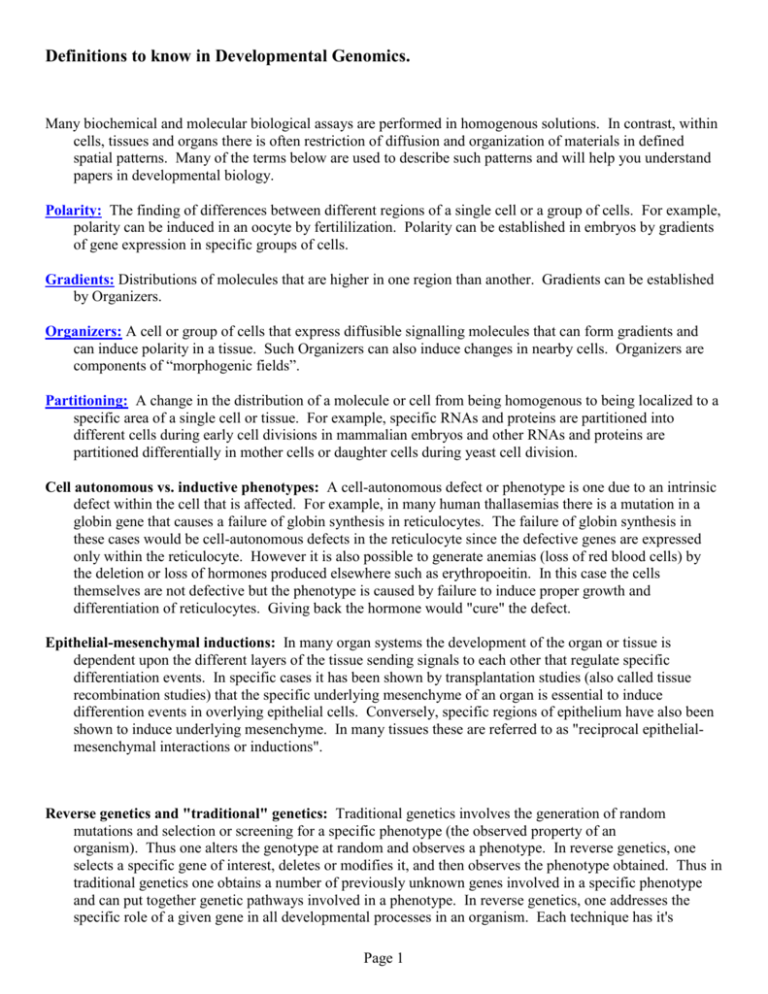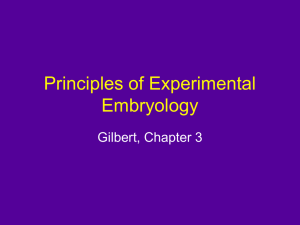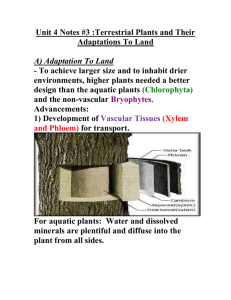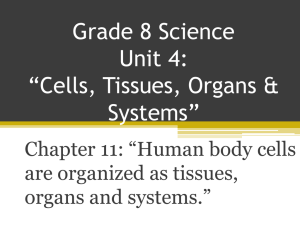Developmental Genomics
advertisement

Definitions to know in Developmental Genomics. Many biochemical and molecular biological assays are performed in homogenous solutions. In contrast, within cells, tissues and organs there is often restriction of diffusion and organization of materials in defined spatial patterns. Many of the terms below are used to describe such patterns and will help you understand papers in developmental biology. Polarity: The finding of differences between different regions of a single cell or a group of cells. For example, polarity can be induced in an oocyte by fertililization. Polarity can be established in embryos by gradients of gene expression in specific groups of cells. Gradients: Distributions of molecules that are higher in one region than another. Gradients can be established by Organizers. Organizers: A cell or group of cells that express diffusible signalling molecules that can form gradients and can induce polarity in a tissue. Such Organizers can also induce changes in nearby cells. Organizers are components of “morphogenic fields”. Partitioning: A change in the distribution of a molecule or cell from being homogenous to being localized to a specific area of a single cell or tissue. For example, specific RNAs and proteins are partitioned into different cells during early cell divisions in mammalian embryos and other RNAs and proteins are partitioned differentially in mother cells or daughter cells during yeast cell division. Cell autonomous vs. inductive phenotypes: A cell-autonomous defect or phenotype is one due to an intrinsic defect within the cell that is affected. For example, in many human thallasemias there is a mutation in a globin gene that causes a failure of globin synthesis in reticulocytes. The failure of globin synthesis in these cases would be cell-autonomous defects in the reticulocyte since the defective genes are expressed only within the reticulocyte. However it is also possible to generate anemias (loss of red blood cells) by the deletion or loss of hormones produced elsewhere such as erythropoeitin. In this case the cells themselves are not defective but the phenotype is caused by failure to induce proper growth and differentiation of reticulocytes. Giving back the hormone would "cure" the defect. Epithelial-mesenchymal inductions: In many organ systems the development of the organ or tissue is dependent upon the different layers of the tissue sending signals to each other that regulate specific differentiation events. In specific cases it has been shown by transplantation studies (also called tissue recombination studies) that the specific underlying mesenchyme of an organ is essential to induce differention events in overlying epithelial cells. Conversely, specific regions of epithelium have also been shown to induce underlying mesenchyme. In many tissues these are referred to as "reciprocal epithelialmesenchymal interactions or inductions". Reverse genetics and "traditional" genetics: Traditional genetics involves the generation of random mutations and selection or screening for a specific phenotype (the observed property of an organism). Thus one alters the genotype at random and observes a phenotype. In reverse genetics, one selects a specific gene of interest, deletes or modifies it, and then observes the phenotype obtained. Thus in traditional genetics one obtains a number of previously unknown genes involved in a specific phenotype and can put together genetic pathways involved in a phenotype. In reverse genetics, one addresses the specific role of a given gene in all developmental processes in an organism. Each technique has it's Page 1 strengths and weaknesses and each is suitable to ask specific questions about the role of genes in development. Knockouts, knockins and transgenes: It is important to distinguish between these three types of genetic modification in the mouse. Transgenes are randomly integrated genes usually containing a promoter and a coding sequence to be expressed. Sometimes coding sequences lacking elements essential for expression are randomly integrated in order to "trap" elements required for expression of a gene. This is called promoter (or sometimes enhancer or polyA site) trapping. A knockout is a site-specific integration that usually deletes an essential part of a gene of interest. A knockin is jargon for replacement of a specific part of a known gene with a new element, either a new gene or a mutation in the gene of interest. Germ layers of vertebrate embryos: Ectoderm (ectos "outside"), the outermost layer which forms the nervous system and skin; Endoderm (endon "within") the innermost layer that forms the lining of the digestive tract and associated organs; Mesoderm (mesos "middle"), the middle layer gives rise to the skeleton, muscle, heart, vasculature, kidneys and reproductive organs. Many organs are made up of contributions by more than one germ layer. Some general cell types: epithelial, endothelial, mesenchymal, blood cells, secretory, others. There are many specific cell types, both circulating and tissue-associated. Epithelial and mesenchymal cells make up much of the solid structure in vertebrates but are specialized in function in different tissues and organs. Epithelial-mesenchymal interactions are important in the formation of many tissues. Page 2 Morphogenesis and Organogenesis: Frequently groups of cells will undergo morphological rearrangement or restructuring to make things like limbs or organs like the lung, liver, heart, brain, etc. When the final tissue is an organ such transformations are called organogenesis and when they're not organs it's referred to as simply morphogenesis. When organs are formed from preexisting groups of cells or tissue the "preorgan" is frequently referred to as an organ primordium or primordial organs. Anlagen: Of German origin the term anlagen refers to any group of relatively undifferentiated cells that is destined to become a particular group of differentiated cells at a later time in development. It is used to identify distinct cell groups in fly development and also in vertebrate development for example the "optic anlagen" is the group of cells that will become the eye in many vertebrates. The term is related to fatemaps, defined cell lineages, and differentiation. Lineages: In some organisms (C. elegans (referred to hereafter as worms) is a good example) individual cells are destined from their time of creation to become specific regions or cells of the final organism. In worms the entire map of cell divisions from the fertilized ovum to the complete adult animals is known. This map is referred to as the Lineage map. In worm jargon, to observe and record the entire cell division pattern of a worm is called "lineaging" the worm. Such lineage maps are useful to determine where in development a specific mutation affects the organism and generates the final phenotype. In vertebrates the cell lineages are somewhat less defined but there are still regions of the early embryo which become destined to differentiate into specific tissues or organs. Later in development the term lineage in used to define the continuous line of distinct cell types that make up the immune system, the hematopoietic system, the skin and other continuously differentiating cells and tissues. Germ cells vs. somatic cells: Germ cells are those that are used in reproduction such as mature sperm and oocytes but also their progenitors. Taken together these cells are known as the germline of the organism and represent a specific cell lineage. Somatic cells are all other cells not functioning in reproduction such as general epithelial cells, mesenchymal cells and blood cells. Stem cells: Stem cells are cells that are capable of both self-renewal and the generation of other differentiated cell types. The term is derived from the stem of a plant, which gives rise by branching events to the more differentiated parts of the plant (leaves). Stem cells come in a number of forms, the best known being pluripotent embryonal stem cells (ES cells) which can differentiate into many different cell types. It appears that stem cells or "stem-like" cells exist in many tissues as part of normal growth and repair processes. It is important to remember that not all "stem cells" are alike and some appear to have restricted lineages into which they can develop. Some labs are referring to some stem cells as "multipotent progenitor cells" to avoid the recent stigma associated with the name stem cells. Differentiating/Differentiation: Changing from one form to another. New properties are expressed and old properties are extinguished. While the term morphogenesis is usually reserved for gross remodeling of multicellular structures, differentiation of the individual cells frequently coincides with morphogenic events. Both individual cells and groups of cells can be said to differentiate into something else. Endocrine, Paracrine and Autocrine effects: Hormones or growth factors can be expressed and have their effects in at least three distinct manners. Endocrine secretion of hormones is secretion into the blood stream so that effects can be had at distal locations. Paracrine effects are one cell secreting a hormone or growth factor locally so that neighboring cells are affected. Autocrine effects are where a cell secretes a substance that then binds back to the same cell, a type of autostimulation. A fourth "crine" effect is Exocrine where a substance is secreted outside of the body of the organism either through the skin or into the intestinal tract. Page 3 Programmed cell death: The first genetic evidence for programmed cell death (apotosis) was found in the nematode C. elegans with the ced (C. elegans death) mutations. These mutations decreased the normal cell death that occurs during C. elegans development. C. elegans adult hemaphrodites contain 959 somatic cells (together with hundreds of germ cells) and during development to the adult stage 131 cells die and are degraded. Thus almost 1/8 of all cells that are made during development are deliberately lost. Many of the genes defined in the ced pathway have been shown to function during apotosis in mammalian cells. Tissue recombination or transplant studies: To demonstrate inductive interactions between epithelial and mesenchymal tissues or between any groups of cells tissue recombination (aka transplant) studies have been performed. Such studies involve either grafting of one piece of tissue to another in vivo or the placement of two tissues abutting each other in vitro. Recently beads soaked in specific growth factors/hormones have been useful to study the inductive signals generated by tissues. Parts of an an embryo: One of the most frustrating things about learning developmental genomics is the huge number of defined parts of embryos that are generated and lost during development. All of the instructors will try to minimize the number of terms that you need to learn, but the fact is that to understand what is going on you need to understand the players involved and that requires remembering a large number of specific embryo parts and a large number of genes. For your own research the number of parts you will need to learn will likely be fewer because you'll be studying a specific subset of developmental processes. A very abbreviated list is below. Germ layers: see above. Neural fold: a region of early vertebrate embryos that is formed from the neural plate and eventually folds together and fuses to become the neural tube, which eventually forms the brain and spinal cord. Page 4 MHP= medial neural hinge point DLHP= dorsolateral hinge point Neural crest cells: These are found only in vertebrates and arise from the tops of the neural folds and then migrate to and seed various regions of the embryo to form large numbers of tissues including cartilage elements of the head, portions of the teeth, pigment cells of the epidermis, several types of neurons, hormone-producing gland cells and smooth muscle cells. They are very versatile! Pharyngeal arches: These are groups of cells that form on the developing "neck" region of vertebrate embryos and are formed from the pharyngeal pouches that bulge from the pharyngeal endoderm and generate pharyngeal clefts. Each arch (I-VI) forms distinct regions of the jaw, ear, larynx and trachea of the term embryo. Neural crest cells migrate into the pharyngeal arches. Below are pharyngeal arches (branchial arches and gill arches) in Salamander. Ectoderm has been removed. Page 5 Rhombomers: These groups of cells are formed within the neural tube from the segmentation of the hindbrain (Rhombencephalon). Each rhombomere goes on to become a nerve ganglion. Neural crest cells migrate into the rhombomers. Ectodermal Placodes: Regions of tissue that form in the Ectodermal layer of the head region and form the inner ear (Otic Placode), the lens (Lens Placode), the olfactory epithelium (Nasal Placode) and the sensory ganglia of cranial nerves. Somites: These are groups of cells that form just outside of and along the neural tube (from paraxial mesoderm) and go on to generate the cells of connective tissue and muscle. The somites are numbered 128 in the chicken from head to tail and each somite forms distinct regions of the term embryo. The mouse has ~60 somites. Positions within an embryo: Sometimes it's hard to know what all the various terms are that describe the 3 dimensional position within an embryo. Here are a few examples: Dorsal: the back of an embryo, sometimes easier to think of as the top of an embryo thats lying on it's "stomach". Think dorsal fin of a fish. Ventral: the "front" of an embryo, where the stomach would be if it had one yet. Anterior (top, cranial, rostral): the "tip of the nose", in front of. Posterior (caudal): the "end of the tail", think posterior, behind. Page 6 Proximal: the region closest in to the body (referring to limbs) or site or origin. Distal: the region farthest out from the body (referring to limbs) or site of origin. Sectioning of embryos: Some of these mean different things whether you're talking about a whole embryo or just a portion of the embyo (like the brain). Sagittal or parasagittal: sections parallel to the long anterior-posterior axis of an embryo from top to bottom (dorsal to ventral) dividing the left and right halves of the embryo. I think of these as "longways" sections. Transverse or cross section: any sections cut perpendicular to the anterior-posterior axis. Coronal: sections perpendicular to the dorsal-ventral axis. In brain anatomy, coronal sections go from the front to the back of the brain. Also known as frontal sections. Page 7







